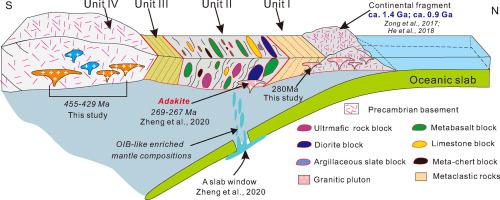Gondwana Research ( IF 6.1 ) Pub Date : 2021-04-09 , DOI: 10.1016/j.gr.2021.02.022 Rongguo Zheng , Jinyi Li , Jin Zhang , Wenjiao Xiao

|
The Beishan complex, located along the Liuyuan suture in the southern Beishan, separates the Dunhuang terrane from the southern Central Asian Orogenic Belt. The ages and origins of the Beishan complex are still controversial. Based on integrated field investigation and petrological, geochronological, and geochemical work, the Beishan complex is interpreted to consist of four diachronous lithologic units with different tectonic origins. Unit I is mainly composed of meta-clastic and minor carbonate rocks; these metaclastic rocks were derived from a proximal source with dominantly intermediate–acidic magmatic materials, and were deposited in a continental arc setting during 430–280 Ma. Unit II exhibits a block-in-matrix structure with variably sized blocks of ultramafic rock, meta-gabbro, Nb-enriched pillow meta-basalt, amphibolite, calc-alkaline mylonitized diorite, marble, argillaceous slate, and quartzitic meta-chert embedded in a matrix of sheared fine-grained sandstone; this tectonic mélange was emplaced during 284–267 Ma. Unit III consists of coherent quartzite, paragneiss, and biotite schist with maximum depositional ages of 1214 Ma, 817 Ma, and 1210 Ma, respectively. Unit IV was formed in a continental arc setting, and predominantly contains early Paleozoic diorite (430 Ma), TTG (455–437 Ma), and tonalite (430–429 Ma), as well as biotite–quartz schist (507–420 Ma). Consequently, we propose that the Beishan complex represents an assemblage of a continental arc and a fore-arc accretionary complex resulting from subduction of the Paleo-Asian oceanic slab. Our results indicate long-lived subduction–accretion of the Paleo-Asian Ocean and the final closure may have occurred posterior to the middle Permian.
中文翻译:

中亚南部造山带的延长俯冲-增生:对北山构造的解剖学和构造亲和力的见解
北山综合体位于北山南部柳园缝合线上,将敦煌地层与中亚造山带南部隔开。北山情结的年代和起源仍存在争议。基于综合的野外调查以及岩石学,地球年代学和地球化学工作,北山综合体被解释为由四个具有不同构造起源的历时岩性单元组成。第一单元主要由超碎屑岩和少量碳酸盐岩组成。这些超碎屑岩是从近端岩浆中提取的,主要是中酸性岩浆物质,并沉积在430-280 Ma的大陆弧环境中。第II单元展示了矩阵结构,其中包括大小不同的超基性岩块,变长石块,富Nb枕形偏玄武岩,角闪石,钙碱性髓鞘闪长岩,大理石,泥质板岩和石英质超白质陶粒,嵌在剪切细粒砂岩的基质中;这种构造混杂岩是在284–267 Ma期间置入的。第三单元由相干的石英岩,Paragneiss和黑云母片岩组成,最大沉积年龄分别为1214 Ma,817 Ma和1210 Ma。第四单元是在大陆弧背景下形成的,主要包含早古生代闪长岩(430 Ma),TTG(455-437 Ma)和to石(430-429 Ma)以及黑云石-石英片岩(507-420 Ma)。 )。因此,我们提出北山复合体是大陆-弧和前弧增生复合体的组合,该复合体是由古亚洲大洋板块俯冲而形成的。



























 京公网安备 11010802027423号
京公网安备 11010802027423号